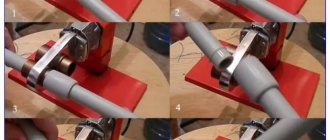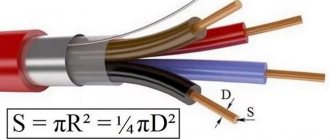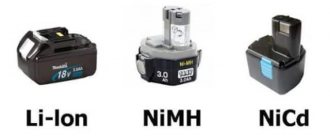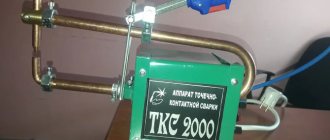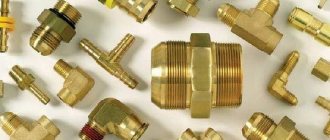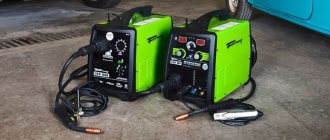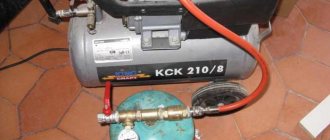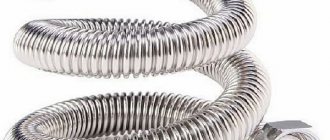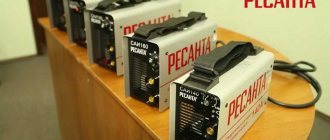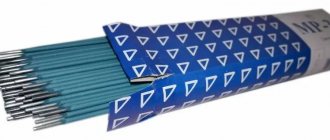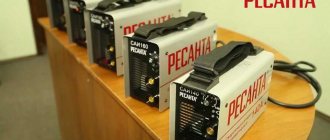When performing metal soldering, there is always a need to use solder, the quality of which directly affects the durability of the completed connection of metal parts. It should be said that solder is a consumable material and is made from various alloys. Manufacturers are constantly improving this material, which ensures high-quality connections and simplifies soldering. Rosin solder is an inexpensive and at the same time high-quality material that is versatile and can be used for soldering various metals.
This solder contains rosin, which eliminates the need to purchase and use additional materials. Rosin simplifies the melting of the surfacing material, which in turn improves the quality of the joint. Another constant advantage of such solder is its low melting point, and this in turn allows you to avoid changing the structure of the base metal being connected.
The flux in the solder is in the form of rosin, so there is no need to use it additionally. This greatly simplifies the soldering procedure, which professionals and ordinary homeowners will appreciate. Note that the percentage of rosin is in the optimal amount, while using it separately, there is a danger of taking more and less material. All this has a positive effect on the quality of welding work performed.
Types of rosin solder
Currently, such solder with rosin is manufactured in several versions. It is customary to distinguish such filler material depending on the rosin content, wire thickness and a number of other features. There is a choice of materials for both home use and soldering on an industrial scale. This solder is produced in the form:
- In reels. This is a universal option for surfacing material that can be used by both professional welders in workshops and ordinary homeowners for soldering at home. The thickness of the wire can vary from 0.8 to 2 millimeters. Note that using such coils is extremely convenient. You just need to select the appropriate brand of solder and wire thickness.
- In a tube. This type of solder is made exclusively for home use. Such a tube contains a minimum of material, so if large volumes are needed, you should either buy a large number of tubes at once or choose solder in a coil.
- In the bays. A large amount of material is used, so this design is intended primarily for industrial use. The thickness of the wire can be varied, depending on the specific needs of customers. The coils themselves can be made in different sizes, which somewhat simplifies their use.
Physico-chemical properties of the solder used
The classic composition of such solder with rosin is considered to be tin-lead soft alloys. The tin content is 60% and lead 40%. Accordingly, such a composition gives such solder certain physical properties. The presence of rosin allows for excellent flexibility, as a result of which, before welding, you can select the right amount of such material and correctly position it in the seam. It must be taken into account that such a composition has a low melting point, so it is not possible to use it for joining refractory metals. At the same time, we note that such solder penetrates in a liquid state into all cavities and irregularities, which ensures the strength of the connection. But at the same time, such an additive does not penetrate into the base material.
Low melting temperatures ensure ease of soldering. Lead adds fluidity to the material, but one should take into account the fact that lead may contain toxic fumes, so it is best to perform soldering in a ventilated area. No further precautions are required when soldering.
General properties of solders
According to their intended purpose, consumables with or without rosin perform one task, soldering electronic elements. You can emphasize the same:
- Form, if the production produces solders in the form of wire.
- High degree of wetting of joined surfaces.
- Using one tool for work - a soldering iron.
- The process involves heating and melting the solder.
- Composition of alloys for low melting temperatures.
- Easy soldering.
There are many different types of solders on sale, which does not create difficulties in choosing them.
How to choose the right solder
When choosing one or another type of such material, you should take into account the convenience of doing the work. In the event that standard work is performed, then you can use solder with any optimal brand of rosin. If you work with so-called PIC materials, it is best to choose solder, the components of which are silver. This will allow you to ensure high strength, softness and subsequent strength of the connection.
In each specific case, depending on the metal alloys used in the solder, its melting point can vary significantly. The choice in this case must be made solely depending on the characteristics of the main metal parts you are connecting. All this will ensure the durability of the soldering and the quality of such a connecting seam.
Also pay attention to the melting point of the solder and metal. The higher the temperature of the base metal, the higher the same indicator should be for the solder. In addition to the brand of such material, you also need to decide on the thickness of the wire. In this case, the choice must be made based on the thickness of the products themselves and the existing thickness of the weld. If you work with a soldering iron, then you can fuse a drop of flux of the required size from wire of any thickness. If you use gas welding, then you should use wire with a thickness of 0.8 to 1.5 millimeters. However, we note that the composition of the material is a much more important characteristic than its thickness.
Read also: Power of LED floodlights table
Types and features of solders without rosin
Electronic elements are not connected by welding; soldering is used during repairs. This process requires good solder and an auxiliary component - rosin or flux of any type. The metal alloy used to fix the parts wets the areas being joined, and the rosin cleans them. The solder must be thermally and electrically stable.
Consumables are:
- Solid with a melting point above 450 degrees.
- Soft.
Consumables produced:
- Granules.
- With rods.
- Wire.
- Powder.
- Foil.
- Plates.
When choosing the right solder, consider:
- Properties of the metal being joined.
- Mechanical strength of the adhesive.
- Corrosion resistance with conductivity.
For fastening boards in radio equipment, the POS-61 due to its acceptable melting point (up to 190 degrees). If you are working with a device sensitive to overheating, choose POSK 50-18. For processing objects with hard properties, the PMC marking, which contains copper and zinc, is suitable. “PSR” indicates an alloy of silver with additives in different percentages:
- Tin.
- Lead.
- Copper.
- Zinc.
There are also samples where phosphorus is added in addition to the metal component.
Features of use
Having correctly identified and selected the solder and rosin used, you can perform the soldering itself. This work is not particularly difficult. It is necessary to perform appropriate surface preparation, for which the base metal is cleaned of existing contaminants and all settling parts.
When preparing a surface for soldering, it must be heated and the solder melted. Remember that there should not be a large difference in temperature between the metal alloys and the solder, as this will subsequently negatively affect the quality of the connection. There is no need to overheat the base metal; subsequently, the solder can spread over such a hot surface, cooling for a long time and not hardening for 10 minutes or more. The presence of rosin greatly simplifies soldering, and the solder quickly hardens, providing mechanical strength to the connection. This ensures the necessary protection of the connection against corrosion.
Currently, solder with rosin from various manufacturers can be found on sale. These can be both domestic companies and foreign manufacturers. It should be said that there is no significant difference between domestic and foreign manufacturers. Therefore, first of all, focus on the composition of the material, its brand and the thickness of the wire. By purchasing solder from domestic manufacturers, you can save a lot. At the same time, you can be completely confident in the quality and durability of the soldered connections of metal elements.
Solder is one of the main consumables used during soldering. This process has existed for a long time and manufacturers are constantly working to improve it. The improvement also applies to consumables. Rosin solder is one of the products of this modernization, which greatly simplifies the soldering process, since it requires less materials. During the standard procedure, you need to use not only the solder itself, but also rosin as a flux. It is necessary in order to simplify the melting of the surfacing material, as well as improve the connection between it and the base metal. Taking into account the fact that the process itself is carried out at relatively low temperatures and does not affect the structure of the base metal, wettability is a very important factor.
In this case, the flux is contained in the solder, so there is no need to use anything additional. This method is convenient for both beginners and professionals. It is worth noting that brands that belong to this type have a good balance. When using rosin separately, there is always a risk that you can take less or more of it. If a brand containing rosin is used, then it will be selected in the optimal quantity according to the selected wire size. These products are manufactured in accordance with GOST 21931-76.
Types of solder with rosin
Solder for soldering with rosin is available in several versions. They depend on the thickness of the wire, its quantity, as well as other features included by the manufacturer. Among them are the following varieties:
- In a tube - this type of solder is produced for private use, since there is a minimal amount of the material itself. In terms of overall capacity and weight, the tube is inferior to the others. In other parameters they remain almost the same, in accordance with the characteristics of their brand.
- Coils are a slightly larger option that can be used both in the private sector and in repair shops, where the material consumption is much higher. The thickness of the wire here can vary within 0.8-2 mm. The main thing is to choose the right brand, since using the coils is very convenient.
- Coils - in this case the largest amount of material is used. This variety is designed primarily for industrial use, since such supplies can be assessed as wholesale. The thickness of the wire can be any, depending on the needs of customers.
Who should use each solder and when?
A radio engineer uses a tubular element, the cavity of which is filled with rosin, when it is necessary to carry out soldering:
- In the device, repair the electronic device.
- For small areas, using tubes or reel kits.
- At an industrial enterprise, if there is a coil, ensuring compliance with all technological processes and properties of the metal being soldered.
- With low melting points.
Soldering without internal fillers allows you to perform actions with different:
- Refractory metals.
- Temperature conditions of melting depending on the composition of the alloy.
- Overheating-sensitive elements - fuses, transistors.
- Radio technical products – wires, technical boards.
- Tin and connect copper and bronze parts to obtain a sealed seam.
The master determines the area of work and selects the substance that is suitable for specific work. It is good to attach radio components using wire with rosin. To connect elements made of bismuth or cadmium, it is better to select separately solder and flux that meet the requirements of the alloys.
Electronics and technologyComment
Composition and physicochemical properties
The classic composition of solder with rosin is ordinary soft tin-lead. The lead content in it is 40%, and tin – 60%. Such solders include POS 60 or a similar brand POS 61.
Thanks to this, it acquires special physical properties. Solder with and without rosin with this composition has special flexibility, which helps to select the desired position before soldering. This composition is characterized by a relatively low melting point, which does not allow the use of solder for soldering refractory metals. However, it penetrates well into all irregularities when in a liquid state. This ensures the highest possible degree of grip. Although there is no penetration into the structure of the base metal, this property makes it possible to cover as large a bonding area as possible.
Relatively low melting point ensures ease of use. The presence of lead adds fluidity to the material. When using, it is better to do everything in a well-ventilated area, as lead produces fumes that are harmful to human health.
Technical characteristics of solder with rosin
Among all brands there are those varieties. Which are used most often. Their technical characteristics provide ease of use and make them practically universal for most procedures.
| Brand | Specifications | |||||
| Melting point, °C | Density, gram/cm square | Thermal conductivity | Tensile strength | Relative elongation, % | ||
| Initial | Ultimate | |||||
| POS 61 | 183 | 189 | 8,5 | 0,12 | 4,3 | 46 |
| POS 60 | 185 | 192 | ||||
| POS 90 | 183 | 189 | 47 MPa (or 4.9 kgf/mm square) | 58 | ||
Read also: DIY galvanic bath
Features of choice
When choosing which is better, solder with or without rosin, you should first of all focus on the ease of soldering. If you are faced with standard procedures, the modes of which are well known, then you can choose solder containing rosin of any suitable brand. Most often, the choice falls on materials from the POS series, in which the main components are silver and tin. This allows for softness and high wettability to be achieved at the expense of lower bond strength.
If you have to join refractory metals, then it is better to use special types of solders, which may not contain flux.”
The higher the melting temperature of the base metal, the higher the melting temperature of the solder should be. This is the main indicator by which experts are guided. In addition to the composition of the brand, you also need to decide on the thickness of the wire. It’s already easier here, since everything depends on the thickness of the product itself. When working with a soldering iron, you can always fuse a drop of the desired size from a wire of any thickness, so there will not be much difference here. To work with gas, you already need to choose the appropriate thickness option. In your arsenal it is worth having both minimum values, from 0.8 mm, and larger values of 1.2 and 1.5 mm. But the composition of the material will always be more important than the thickness.
Features of application
Having decided which solder is better, with or without rosin, and also having selected the appropriate brand, you can proceed directly to soldering. As when working with simple solder, the first step is to prepare the surface of the base metal; it needs to be cleaned.
Despite the easier process, the presence of rosin does not eliminate most of the negative factors affecting the quality of soldering.”
After preparation, you need to heat its surface to the desired temperature and start using solder. This is required so that there is not a big contrast between the temperatures of the molten solder and the base metal, so you shouldn’t overheat too much either. After the molten solder spreads over the surface, it must be allowed to cool. Thus, soldering of this type has only one important distinctive feature, since there is no need to use additional flux. Its presence in the composition makes the process as easy as when adding rosin separately.
Popular manufacturers
On the domestic market you can find the following manufacturers of these products:
- KievTsvetMet;
- Solder;
- Vadis-M;
- Technoscrap;
- Manwell;
- "Technological Lines";
- Ukr-Spetssplav;
- Arsenal;
- UkrInterstal.
Every radio amateur or DIY repairman will sooner or later be forced to pick up a soldering iron and try it. The quality of the work performed and even the performance of the product will directly depend on many factors, which you must know about before starting work.
Technology and terminology
The starting material for the production of rosin is ordinary pine resin, which, in addition to rosin, contains volatile turpentine compounds.
The manufacturing process involves purifying the rosin by evaporating these compounds.
For those who have never used a soldering iron, but are planning to learn how to solder, it will be useful to know some technical terms.
Soldering is the process of connecting two radio components together through heating.
The soldering tool is a soldering iron, usually powered by 220 mains power with a rated power of 40W.
The soldering process is carried out using a soldering iron tip due to the fact that solder heated to a high temperature grabs two parts together, filling the space between them.
GOST defines solder as a metal or an alloy of several metals. According to GOST, 26 categories of solder are defined depending on the element used.
The most popular alloy is lead and tin in various proportions. Price also plays an important role in popularity.
Solders always have a lower melting point than the parts to be joined.
According to GOST, according to their temperature properties, solders are divided into soft ones, which melt at temperatures up to 450 degrees Celsius (with subcategories of particularly low-melting ones - up to 145 ° C and hard ones with a melting point of 450 degrees Celsius and above (categories of medium-melting - up to 1100 ° C, high-melting - from 1100 to 1850ºС and refractory – over 1850).
GOST divides solders into fluxing and self-fluxing; they have different melting points.
Most often, solders look like a silver-colored metal tube or like a hollow cylinder filled with rosin, which acts as a flux.
Video:
Flux is a composition (liquid or solid) that promotes better contact of parts being soldered and prevents metal oxidation on working surfaces.
Requirements for fluxes are also determined by GOST; they have different prices.
IMPORTANT TO KNOW: Argon-arc welding technology
For a beginner, solder with rosin will be more convenient, while experienced craftsmen like to solder with ordinary solder, choosing a flux depending on the soldering conditions and the material of the parts.
If simple soldering of copper parts will be carried out, then you can use rosin; its low price makes it a convenient consumable.
When more complex soldering is carried out, instead of one universal one, a flux is used that is suitable for all parts.
Technical requirements for the use of rosin for soldering, its composition, melting temperature and characteristics are determined by GOST 19113-84.
The main material for rosin is pine resin - the raw material for many types of industry and an auxiliary element for soldering.
It is a composition in the form of a mixture of abietic resin acid with several other isomers of resin acids.
Lacking a crystalline structure, it is an amorphous, glass-like, brittle substance with a wide range of colors from pale yellow to dark brown.
In composition, it is a glassy, transparent mass with inclusions of air bubbles, with minor inclusions of mechanical impurities, a mass fraction of water not exceeding 0.2%.
It is absolutely insoluble in water, but easily dissolves under the influence of alcohol and acetone. Rosin softening occurs at a temperature not lower than 66-69ºС, depending on the variety.
Proper use of a soldering iron
Despite the apparent simplicity of working with a soldering iron, it is very desirable to have initial skills in high-quality work and be able to correctly use solder with rosin.
Soldering is done using a variety of solders. The so-called solder in a rosin reel is perhaps the most popular. When performing work related to soldering, solder is used. The amount of tin and lead it contains is 60 and 40%, respectively. This alloy melts at 180 degrees.
What is needed to work with a soldering iron:
Heated solder will create a sufficient internal bond with metals such as copper, brass, silver, etc., if the following conditions are met:
- The surfaces of the parts must be cleaned of oxides.
- The part at the soldering site is heated above the melting point of the solder itself.
- During operation, the soldering area must be protected from exposure to oxygen; various fluxes are used for this purpose. They create a protective film directly above the soldering area.
A book on how to solder can be read and understood, but soldering skills can only be learned through practice.
Solder material composition
The tubes contain both traditional and special solders.
As a solder mass for many metals and alloys, in particular for copper, a conventional alloy of tin and lead with eutectic properties is used.
The ratio of metals may vary to some extent. Recommendations for the use of such tubes correspond to the instructions for the use of homogeneous solders made of tin and lead.
For surface mounting work, it is better to choose products with a diameter from 0.46 to 1 mm. To solder miniature parts, flux solders containing silver additives are produced. The maximum melting point of the product is 188℃. The diameter of such tubes is 0.46 mm and 0.56 mm.
Solders with tin and copper have higher melting points, reaching 227℃. Their tin content varies. Tubes are produced with fluxes in which the tin concentration is 95.5% and 99%. Some types of products contain silver additives.
For soldering elements of aluminum lamps, special solders with fluxes containing 80% lead, 18% tin and about 2% silver are supplied. Slight variation in the ratio of components allows you to expand the range of melting temperatures. The minimum is 178, the maximum is 270 ℃.
In most cases, the tubes contain purified rosin as fluxes. Strict dosing almost completely eliminates the possibility of residue formation. If any are discovered after finishing work, they do not need to be deleted.
When choosing consumables, you should pay attention to the manufacturer's information. The technology for producing solders with flux is quite simple, which increases the likelihood of counterfeits.
In low-quality products, the ratio of external and internal components may be disrupted. In professional production, the flux content usually varies from 1% to 4% of the total weight of the tube.
Tricks and secrets of working with a soldering iron
After the solder has begun to melt, it can already be used for soldering. To do this, you need to cover the soldering iron tip with a thin layer of solder, and then wipe it thoroughly on a damp sponge. This is how the solder and rosin remaining from work are removed. It won’t hurt to get into the habit of wiping the tip with a wet sponge every time after soldering.
Before you start soldering a radio component, you need to prepare it. Its leads should be bent so that the part fits freely into the holes intended for it.
Beginners without experience often touch the soldering area with the tip of the soldering iron tip. And you need to hold the soldering iron so that the contact area between it and the place of soldering is as large as possible, otherwise the place where you need to solder does not heat up enough to hold the parts together.
How to solder with rosin
In general terms, the soldering process consists of the following operations:
- Mechanical cleaning of joined surfaces;
- Warming up the soldering iron tip;
- Heating of connected surfaces;
- Treatment of the sting with rosin;
- Surface treatment with rosin;
- Coating the tip with solder (tinning);
- Connecting parts and covering the joint and adjacent areas with solder.
- Cooling the connection.
Now, more details about each operation?
- Rosin is capable of dissolving oxide films and partially reducing them to metal. If the surface of the parts to be joined is not covered with visible dirt, this operation can be skipped. It is necessary when dirt or oxides cover the surface so much that they prevent it from being wetted by molten rosin and then solder.
- It was previously mentioned that the temperature at which rosin begins to soften is around 55 – 70ºC. But in order to reliably cover the soldering iron tip and the parts being connected, it must be heated to 100 - 130ºC. The criterion for a sufficient tip temperature is its free penetration into the solid rosin mass with the appearance of a slight haze.
- The need to heat the surfaces to be joined depends very much on their size. If you have thin wires to solder, you can skip this operation. You must understand that on a cold surface the rosin and solder will rapidly cool and solidify. As a result, it will not be possible to achieve dissolution of oxides with rosin and sufficient spreading of solder. Therefore, before starting soldering, it is necessary to assess whether it is possible to warm up the parts already during flux treatment or whether this must be done first.
- If the soldering iron is being used for the first time or has not been used for a long time, you can go over the tip with a wire brush or fine sandpaper. But this is required in the most advanced cases. Usually it is enough to heat it up and treat it with rosin, and then cover it with a layer of tin - tin it. Now the tip is ready for use.
If the break in work was short, and the tip remained covered with solder, tinning is not required, just heat it and dip it in rosin.
- Next, we prepare the surface of the parts for soldering. As already mentioned, it may be necessary to heat the joint surfaces of the parts being connected. This is determined by their massiveness and the size of the soldering iron tip. If the tip is more massive than the parts, you can do without preheating before soldering, but do it directly during the processing of the parts with rosin.
We fix the surfaces to be joined in the position in which they will be mounted, heat them if necessary, treat them with flux and then apply molten solder. Using the soldering iron tip, we help it spread over the joint and adjacent areas, and let the joint cool.
The soldering process is completed.
Types of nickel-plated soldering tips
- A needle-shaped tip is used for soldering very small radio components, such as SMD. When repairing phones, such a tip is indispensable. It is used on boards with a high density of mounted parts.
- Tip-spatula - used for desoldering and in cases of installation of large radio components. They work with multi-pin microcircuits.
- The tip is in the shape of a drop - it is convenient for them to transfer solder with rosin to the place of soldering, which leads to improved quality of work.
- A tip with a curved shape - most often it is used to solder radio components that are in a copper shell, so that no excess solder remains on the board. It can also be used for regular soldering. The soldering iron heats up to a temperature of 290-300 C.
Read also: Ferrous metallurgy production technology
When working with a soldering iron, you must always keep it perfectly clean. New soldering tips are usually hammered to create fine nicks on the surface. Subsequently, they are carefully trimmed with a file to give the tip the most correct shape.
Then the tip should be tinned using solder with rosin. That is, cover with a thin layer of solder, dipping it in rosin.
Secrets of soldering with a soldering iron
To obtain a good result when soldering, you must correctly use solder with rosin and flux. This is a low-melting alloy of a special metal that is used to solder the leads of parts and wires.
- The best solder is pure tin. But such metal is too expensive to be used for soldering. Therefore, when working with radio components, so-called lead-tin solders are used.
- Lead with tin. In terms of soldering strength, these solders are no worse than pure tin. They melt at a temperature of 170-190 degrees. It is customary to denote such solders by the abbreviation “POS” - tin-lead solder. The number after these letters in the designation means the share of tin, expressed as a percentage. It is better to use POS-6O solder.
- Fluxes are substances that have antioxidant properties. They are used to prevent oxidation of the soldering area. If you don't use flux, the solder simply won't stick to the metal surface.
Types of fluxes
When working with radio components, fluxes that do not contain acid are used. For example, rosin. Bow rosin for lubricating musical instruments is also sold in stores. It can also be used for soldering. But metal utensils are soldered using solder without rosin. To repair it you will need “soldering acid”. This is zinc dissolved in hydrochloric acid. It is also impossible to solder radio components with such solder, since over time it will destroy the soldering.
If you need to solder in hard-to-reach places, you need to have liquid flux. You can make it yourself. Rosin is crushed into powder and poured into acetone or ethyl alcohol. After mixing the solution, you need to add more rosin until you obtain a thick, mushy mass. Such liquid rosin should be applied to soldering areas with a brush or stick. There is a caveat - to work with printed circuit boards, the flux must be more liquid. For hard-to-reach places, you can also use wire solder with rosin, which is much more convenient.
When working with various fluxes, it is necessary to take into account that those that contain acetone are very toxic. Therefore, when working with them, it is necessary to avoid getting vapors into the respiratory tract. It is better to solder near a window if it is summer, and in winter it is better to ventilate the room in which the work is being carried out. After finishing work, be sure to wash your hands with soap and warm water.
